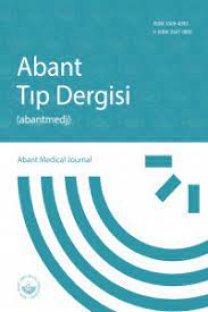Bilgisayarlı Toraks Tomografisini Gereğinden Fazla mı İstiyoruz?
Göğüs hastalıkları, poliklinik, toraks tomografisi
Do We Want Thorax Computed Tomography much more than Required?
Pulmonary diseases, polyclinic, thorax tomography,
___
- 1. Seynaeve PC, Broos JI. The history of tomography. J Belge Radiol. 1995; 78(5): 284-8.
- 2. Huppmann MV, Johnson WB, Javitt MC. Radiation risks from exposure to chest computed tomography. Semin Ultrasound CT MR. 2010; 31(1): 14-8.
- 3. Beigelman C. Computed tomography in 2000: technique, expected progress, limitations,indications. Rev Pneumol Clin. 2000; 56(2): 73-81.
- 4. Bennett LM. Breast cancer: Genetic predisposition and exposure to radiation Molecular Carcinogenesis 1999; 26: 143-9.
- 5. Arslanoğlu A, Bilgin S, Kubalı Z, Ceyhan MN, İlhan MN, Maral I. Doctors’ and intern doctors’ knowledge about patients’ ionizing radiation exposure doses during common radiological examinations. Diagn Interv Radiol 2007; 13: 53-5.
- 6. Cimmino CV. Overutilization of radiological examinations. Radiology 1977 ; 123(1): 241.
- 7. Hall FM. Overutilization of radiological examinations. Radiology 1976; 120(2): 443-8.
- 8. Armao D, Semelka RC, Elias JJ. Radiology's ethical responsibility for healthcare reform: tempering the overutilization of medical imaging and trimming down a heavyweight. J Magn Reson Imaging. 2012; 35(3): 512-7.
- 9. Lu MT, Tellis WM, Fidelman N, Qayyum A, Avrin DE. Reducing the rate of repeat imaging: import of outside images to PACS. AJR Am J Roentgenol. 2012; 198(3): 628-34.
- 10. Hendee WR, Becker GJ, Borgstede JP, Bosma J, Casarella WJ, Erickson BA, Maynard CD, Thrall JH, Wallner PE. Addressing overutilization in medical imaging. Radiology 2010; 257(1): 240-5.
- 11. Zondervan RL, Hahn PF, Sadow CA, Liu B, Lee SI. Frequent body CT scanning of young adults: indications, outcomes, and risk for radiationinduced cancer. J Am Coll Radiol 2011; 8(7): 501-7.
- 12. Giles J. Study warns of ‘avoidable’ risks of CT scans. Nature 2004; 431: 391.
- 13. Berrington de Gonzalez A, Mahesh M, Kim KP, Bhargavan M, Lewis R, Mettler F, Land C. Projected cancer risks from computed tomographic scans performed in the United States in 2007. Arch Intern Med. 2009; 169(22): 2071-2.
- 14. Hall EJ, Brenner DJ. Cancer risks from diagnostic radiology. Br J Radiol 2008; 81(965): 362-78.
- 15. Brenner DJ, Elliston CD, Hall EJ, Berdon WE. Estimates of the cancer risks from pediatric CT radiation are not merely theoretical. Med Phys 2001; 28: 2387-8.
- 16. Sources and effects of ionizing radiation: United Nations Scientific Committee on the Effects of Atomic Radiation: UNSCEAR 2000 report to the General Assembly. NewYork: United Nations, 2000.
- 17. Berrington de Gonzalez A, Darby S. Risk of cancer from diagnostic X-rays: estimates for the UK and 14 other countries. Lancet 2004; 363: 345-51.
- 18. Sağlık Bakanlığı Sağlık Araştırmaları Genel Müdürlüğü Sağlık İstatistikleri Yıllığı 2011, http://sbu.saglik.gov.tr/Ekutuphane/kitaplar/siy_20 11.pdf, erişim tarihi: 01.02.2014
- 19. Svavarsdóttir AE, Jónasson MR, Gudmundsson GH, Fjeldsted K. Chest pain in family practice. Diagnosis and long-term outcome in a community setting. Can Fam Physician. 1996; 42: 1122-8.
- 20. The International Early Lung Cancer Action Program Investigators. Survival of Patients with Stage I Lung Cancer Detected on CT Screening N Engl J Med 2006; 355: 1763-71
- Yayın Aralığı: Yılda 6 Sayı
- Başlangıç: 2012
- Yayıncı: Bolu Abant İzzet Baysal Üniversitesi Tıp Fakültesi Dekanlığı
Erişkin Yaş Gruplarında Hepatit A Seroprevalansı
Bilge GÜLTEPE, Mehmet Ziya DOYMAZ, Meryem IRAZ
Lomber disk herniasyonunda neovaskülarizasyonla ilişkili rezorbsiyon mekanizmaları
Hatice Rana ERDEM, Bünyamin KOÇ, Barış NACIR
Spontan tromboze olan rüptüre aort anevrizması
Ayla BÜYÜKKAYA, Sibel YAZGAN, Ramazan BÜYÜKKAYA, Ömer YAZGAN
Tanıda gecikilmiş ve yüzde geniş skar bırakmış bir kutanöz leishmania olgusu
Sevil ALAN, Cumhur İbrahim BAŞSORGUN
Korunmuş Sol Ventrikül Sistolik Fonksiyonlu Ciddi Sol Ana Koroner Arter Tıkanması
Posttravmatik apandisit; gerçek mi söylenti mi?
Ahmet Orhan ÇELİK, Tuğba İlkem ÖZÇAĞLAYAN, Ahmet SÜMBÜL, Ayşegül ALTUNKAŞ
Okul öncesi dönemde ağır hışıltı atağı ile ilişkili risk faktörleri
Mehmet ASLAN, Ahmet KURT, Ramazan ÖZDEMİR, Ferhat ÇATAL, Gülsüm DEMİRTAŞ, Elif ŞENBABA, Ahmet KARADAĞ, Erdem TOPAL
Geç Dönem Solar Makülopatili Bir Olgu
Defne KALAYCI, Mesut ERDURMUŞ, Remzi MISIR
Lipid panelinde Non -HDL kolesterol ve Total kolesterol / HDL kolesterol oranı
İbrahim KAPLAN, Hatice YÜKSEL, Tahsin CELEPKOLU, Gülten TOPRAK, Leyla ÇOLPAN, Nurefşan AYDENİZ, Emel ETİK
Nilüfer ÖZKAN, Aysun TORUN CAGLAR, Mehtap MUGLALI, Mehmet Ziya YILMAZ, Feyza SENTÜRK
